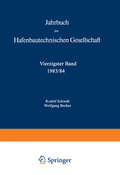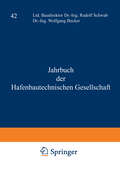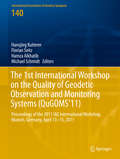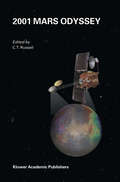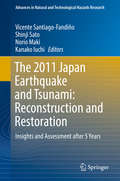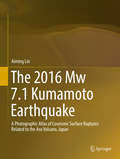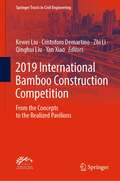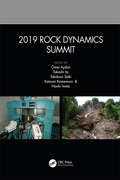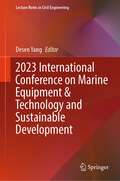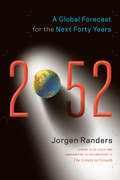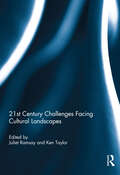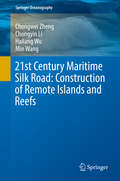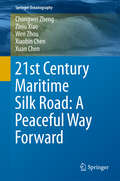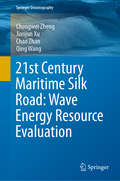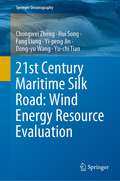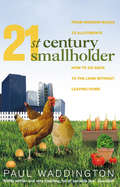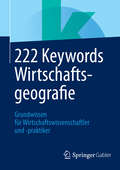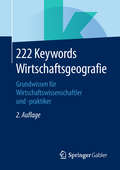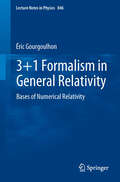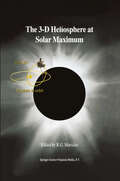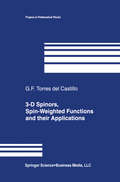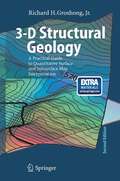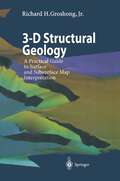- Table View
- List View
The 1st International Workshop on the Quality of Geodetic Observation and Monitoring Systems: Proceedings of the 2011 IAG International Workshop, Munich, Germany April 13–15, 2011 (International Association of Geodesy Symposia #140)
by Hansjörg Kutterer Florian Seitz Hamza Alkhatib Michael SchmidtThese proceedings contain 25 papers, which are the peer-reviewed versions of presentations made at the 1st International Workshop on the Quality of Geodetic Observation and Monitoring (QuGOMS’11), held 13 April to 15 April 2011 in Garching, Germany. The papers were drawn from five sessions which reflected the following topic areas: (1) Uncertainty Modeling of Geodetic Data, (2) Theoretical Studies on Combination Strategies and Parameter Estimation, (3) Recursive State-Space Filtering, (4) Sensor Networks and Multi Sensor Systems in Engineering Geodesy, (5) Multi-Mission Approaches With View to Physical Processes in the Earth System.
2001 Mars Odyssey
by C. T. RussellMars, the most habitable of our sister planets, holds a special place in our imaginations and in our space exploration program. Fully half of NASA's planetary exploration effort is now devoted to Mars. Key questions include: Has Mars ever harbored life? Is there life on Mars now? Will humans be able to survive on the Martian surface? Answers to these questions lie in determining the present location of water on Mars and its likely inventory in the past, and in determining the present radiation environment of Mars. The 2001 Mars Odyssey Mission contributes greatly these answers by detecting near-surface water through measurements of neutron flux, from the detection of carbonates, and the quantification of its radiation environment. This book captures the objectives, the design of the mission and the details of the instruments carried to Mars. It should be of interest to every scientist interested in participating in the on-going exploration of Mars from graduate students to senior scientists as it provides the background information essential to interpret the many exciting results now appearing from the mission.
The 2011 Japan Earthquake and Tsunami: Insights and Assessment after 5 Years (Advances in Natural and Technological Hazards Research #47)
by Vicente Santiago-Fandiño Shinji Sato Norio Maki Kanako IuchiThis book covers the restoration and reconstruction process and activities undertaken in Japan in the first five years since the 2011 Earthquake and Tsunami – a period widely considered to be the most intensive reconstruction phase within the 10-year restoration plan drawn up by the Japanese Government. The respective chapters explore technical, scientific, social and non-scientific (policy-related) aspects, including: reconstruction and restoration policies, infrastructure and designs for tsunami coastal defence, resilient urban areas and affected communities, housing and relocation schemes, disaster mitigation and evacuation measures, reactivation of the economy, revitalization of fisheries and coastal agriculture, and industry and tourism. The book also illustrates some of the achievements and failures in a broad range of projects and initiatives intended to address the above-mentioned issues, making it particularly relevant for experts, decision makers, students and other interested scholars.
The 2016 Mw 7.1 Kumamoto Earthquake: A Photographic Atlas of Coseismic Surface Ruptures Related to the Aso Volcano, Japan
by Aiming LinThis book shows the deformation characteristics of coseismic surface ruptures produced by the 2016 Kumamoto earthquake and the relationship between the Aso volcano and active faults. In particular, the rupturing mechanisms and processes involved in the seismogenic faults related to the crustal structure under the Aso volcano caldera are covered. The book is intended to help bridge the gaps between seismology, seismic disaster prevention, volcanology, seismotectonics, and geology and to encourage further studies of earthquake mechanisms and seismic faulting processes.
2019 International Bamboo Construction Competition: From the Concepts to the Realized Pavilions (Springer Tracts in Civil Engineering)
by Kewei Liu Cristoforo Demartino Zhi Li Qinghui Liu Yan XiaoThis volume builds upon the 2019 International Bamboo Construction Competition (IBCC 2019) from the Concepts to the Realized Pavilions. Several designed projects are described, and particular attention is devoted to the realized prototypes. It also presents the Bamboo Eye, an important example of architecture realized by INBAR for the 2019 Beijing Horticultural Expo. As such, the volume provides an overview of the use of bamboo poles and engineered bamboo products for temporary and normal constructions, and represents a compact review of the applications of bamboo poles and/or engineered bamboo products in the construction industry. This book will be of interest for researchers, architects and structural engineers in field of bamboo constructions.
2019 Rock Dynamics Summit: Proceedings of the 2019 Rock Dynamics Summit (RDS 2019), May 7-11, 2019, Okinawa, Japan
by Ömer Aydan Takashi Ito Takafumi Seiki Katsumi Kamemura Naoki IwataRock dynamics has become one of the most important topics in the field of rock mechanics and rock engineering, and involves a wide variety of topics, from earthquake engineering, blasting, impacts, failure of rock engineering structures as well as the occurrence and prediction of earthquakes, induced seismicity, rock bursts to non-destructive testing and explorations. Rock dynamics has wide applications in civil and infrastructural, resources and energy, geological and environmental engineering, geothermal energy, and earthquake hazard management, and has become one of the most topical areas. 2019 Rock Dynamics Summit contains 8 keynote addresses and 128 regular full papers that were presented at the 2019 Rock Dynamics Summit (2019 RDS, Okinawa, Japan, 7-11 May 2019), a specialized conference jointly organized by the Rock Dynamics Committee of the Japanese Society of Civil Engineers (JSCE-RDC), the Japanese Society for Rock Mechanics (JSRM), and which was supported by the International Society for Rock Mechanics and Rock Engineering (ISRM) and the Turkish National Society for Rock Mechanics (TNSRM). The contributions cover a wide range of topics on the dynamic behavior of rock and rock masses and scientific and engineering applications, and include: - Laboratory tests on Dynamic Responses of Rocks and Rock Masses / Fracturing of Rocks and Associated Strong Motions- Estimation Procedures and Numerical Techniques of Strong Motions Associated with the Rupture of Earth’s Crust and Some Strong Motion- Dynamic Response and Stability of Rock Foundations, Underground Excavations in Rock, Rock Slopes Dynamic Responses and Stability of Stone Masonry Historical Structures and Monuments- Induced Seismicity- Dynamic Simulation of Loading and Excavation- Blasting and machinery induced vibrations- Rockburst, Outburst, Impacts- Nondestructive Testing Using Shock Waves- Case Histories of Failure Phenomenon in Rock Engineering 2019 Rock Dynamics Summit contains the state-of-the-art in rock dynamics, and will be invaluable to professionals and academics interested in the latest advances in new techniques for experiments, analytical and numerical modelling as well as monitoring in dynamics of rocks and rock engineering structures.
2019 Rock Dynamics Summit: Proceedings of the 2019 Rock Dynamics Summit (RDS 2019), May 7-11, 2019, Okinawa, Japan
by Ömer Aydan Takashi Ito Takafumi Seiki Katsumi Kamemura Naoki IwataRock dynamics has become one of the most important topics in the field of rock mechanics and rock engineering, and involves a wide variety of topics, from earthquake engineering, blasting, impacts, failure of rock engineering structures as well as the occurrence and prediction of earthquakes, induced seismicity, rock bursts to non-destructive testing and explorations. Rock dynamics has wide applications in civil and infrastructural, resources and energy, geological and environmental engineering, geothermal energy, and earthquake hazard management, and has become one of the most topical areas. 2019 Rock Dynamics Summit contains 8 keynote addresses and 128 regular full papers that were presented at the 2019 Rock Dynamics Summit (2019 RDS, Okinawa, Japan, 7-11 May 2019), a specialized conference jointly organized by the Rock Dynamics Committee of the Japanese Society of Civil Engineers (JSCE-RDC), the Japanese Society for Rock Mechanics (JSRM), and which was supported by the International Society for Rock Mechanics and Rock Engineering (ISRM) and the Turkish National Society for Rock Mechanics (TNSRM). The contributions cover a wide range of topics on the dynamic behavior of rock and rock masses and scientific and engineering applications, and include: - Laboratory tests on Dynamic Responses of Rocks and Rock Masses / Fracturing of Rocks and Associated Strong Motions- Estimation Procedures and Numerical Techniques of Strong Motions Associated with the Rupture of Earth’s Crust and Some Strong Motion- Dynamic Response and Stability of Rock Foundations, Underground Excavations in Rock, Rock Slopes Dynamic Responses and Stability of Stone Masonry Historical Structures and Monuments- Induced Seismicity- Dynamic Simulation of Loading and Excavation- Blasting and machinery induced vibrations- Rockburst, Outburst, Impacts- Nondestructive Testing Using Shock Waves- Case Histories of Failure Phenomenon in Rock Engineering 2019 Rock Dynamics Summit contains the state-of-the-art in rock dynamics, and will be invaluable to professionals and academics interested in the latest advances in new techniques for experiments, analytical and numerical modelling as well as monitoring in dynamics of rocks and rock engineering structures.
2023 International Conference on Marine Equipment & Technology and Sustainable Development (Lecture Notes in Civil Engineering #375)
by Desen YangThis book contains original, peer-reviewed, and selected research papers that were presented at the 2023 International Conference on Marine Equipment & Technology and Sustainable Development, which took place in Beijing, China on April 1st 2023. The papers cover a range of topics, including but not limited to: the vision and goals of building a maritime community with a shared future, marine machinery and transportation, marine ecology, environmental protection and conservation, marine safety, future ships and marine equipment, marine engineering, marine information and technology, maritime policy, and global governance.The papers included in this volume provide the latest findings on methodologies, algorithms, and applications in marine equipment and technology, as well as sustainable development. As a result, this book is an invaluable resource for researchers, engineers, and university students who are interested in these fields.
2052: A Global Forecast for the Next Forty Years
by Jorgen RandersForty years ago, The Limits to Growth study addressed the grand question of how humans would adapt to the physical limitations of planet Earth. It predicted that during the first half of the 21st century the ongoing growth in the human ecological footprint would stop-either through catastrophic "overshoot and collapse"-or through well-managed "peak and decline." So, where are we now? And what does our future look like? In the book 2052, Jorgen Randers, one of the coauthors of Limits to Growth, issues a progress report and makes a forecast for the next forty years. To do this, he asked dozens of experts to weigh in with their best predictions on how our economies, energy supplies, natural resources, climate, food, fisheries, militaries, political divisions, cities, psyches, and more will take shape in the coming decades. He then synthesized those scenarios into a global forecast of life as we will most likely know it in the years ahead. The good news: we will see impressive advances in resource efficiency, and an increasing focus on human well-being rather than on per capita income growth. But this change might not come as we expect. Future growth in population and GDP, for instance, will be constrained in surprising ways-by rapid fertility decline as result of increased urbanization, productivity decline as a result of social unrest, and continuing poverty among the poorest 2 billion world citizens. Runaway global warming, too, is likely. So, how do we prepare for the years ahead? With heart, fact, and wisdom, Randers guides us along a realistic path into the future and discusses what readers can do to ensure a better life for themselves and their children during the increasing turmoil of the next forty years.
21st Century Challenges Facing Cultural Landscapes
by Juliet Ramsay and Ken TaylorThrough stories of diverse landscapes from around the world, this book captures human cultures and their land use practices in the environments they inhabit. The chapters cover topics from heritage in the 21st Century, appreciating and safeguarding values while facing challenges wrought by change.This title will lead readers through fascinating stories of landscapes and people. We learn of the physical and spiritual structure of rice terraces of the Honghe Mountains in China maintained by following a 1300 year sustainable practice of water allocation, while the colonial tea plantations of the Sri Lankan highlands are managed by Indian Tamils who now seek tourism as a means of additional income. Sustainable agricultural methods in the USA are being introduced to prevent landscape loss while in Australia a challenge confronting family farms is progressing to rural industrialisation. Challenges are further outlined in the mythical story of Finland's Saint Henrik pilgrimage and in the intangible Ui-won gardens of Korea. The huge challenge for Japan's landscapes is the legacy from fierce natural 21st Century disasters while in Australia's Dampier Archipelago, an avoidable yet brutal development on a unique Aboriginal rock sculptured landscape highlights serious concerns about heritage governance. These remarkable stories of landscapes and their management are inseparable from the communities that inhabit them. This book was originally published as a special issue of Landscape Research.
21st Century Challenges Facing Cultural Landscapes
by Juliet Ramsay Ken TaylorThrough stories of diverse landscapes from around the world, this book captures human cultures and their land use practices in the environments they inhabit. The chapters cover topics from heritage in the 21st Century, appreciating and safeguarding values while facing challenges wrought by change.This title will lead readers through fascinating stories of landscapes and people. We learn of the physical and spiritual structure of rice terraces of the Honghe Mountains in China maintained by following a 1300 year sustainable practice of water allocation, while the colonial tea plantations of the Sri Lankan highlands are managed by Indian Tamils who now seek tourism as a means of additional income. Sustainable agricultural methods in the USA are being introduced to prevent landscape loss while in Australia a challenge confronting family farms is progressing to rural industrialisation. Challenges are further outlined in the mythical story of Finland's Saint Henrik pilgrimage and in the intangible Ui-won gardens of Korea. The huge challenge for Japan's landscapes is the legacy from fierce natural 21st Century disasters while in Australia's Dampier Archipelago, an avoidable yet brutal development on a unique Aboriginal rock sculptured landscape highlights serious concerns about heritage governance. These remarkable stories of landscapes and their management are inseparable from the communities that inhabit them. This book was originally published as a special issue of Landscape Research.
21st Century Maritime Silk Road: Construction of Remote Islands and Reefs (Springer Oceanography)
by Chongwei Zheng Chongyin Li Hailang Wu Min WangThis book focuses on the construction of remote islands and reefs in the Maritime Silk Road. Firstly, it analyzes the functions, necessity and difficulties of the construction of remote islands and reefs; then provides corresponding countermeasures. According to the urgent demand of electricity and freshwater, it focus on wave and offshore wind energy evaluation of the important remote islands and reefs of the Maritime Silk Road, providing reference for the choice of location of power plants, daily operation and long term plan of wave/wind power generation. Several important key points are selected in the case study to realize their electricity and freshwater self-sufficiency and thus to improve their viability. This book also presents the marine characteristics (especially hazardous elements) under the demands of island runway construction and marine new energy development, to promote safe and efficient implementation of the remote islands and reefs construction. This book is one of the series of publications on the 21st Century Maritime Silk Road (shortened as “Maritime Silk Road”). It covers the characteristics of the marine environment and marine new energy, remote islands and reefs construction, climate change, early warning of wave disasters, legal escort, marine environment and energy big data construction, etc. contributing to the safe and efficient construction of the Maritime Silk Road. It aims to improve our knowledge of the ocean, thus to improve the capacity for marine construction, enhance the viability of remote islands and reefs, ease the energy crisis and protect the ecological environment, improve the quality of life of residents along the Maritime Silk Road, and protect the rights, interests of the countries and regions participating in the construction of the Maritime Silk Road. It will be a valuable reference for decision-makers, researchers, and marine engineers working in the related fields.
21st Century Maritime Silk Road: A Peaceful Way Forward (Springer Oceanography)
by Chongwei Zheng Ziniu Xiao Wen Zhou Xiaobin Chen Xuan ChenThis book focuses on understanding the characteristics of the marine environment; overall characteristic of the marine resources (especially the marine new energy) and their current utilization; important routes, channels, and ports; and the Maritime Silk Road from the perspective of international law. It also discusses the significance and opportunities of the Maritime Silk Road initiative, analyzes the challenges involved in the construction of the Maritime Silk Road and provides corresponding countermeasures. Based on the above research, this book also proposes to construct a comprehensive application platform for the Maritime Silk Road that will be a practical tool for decision-making. This book is one of the series publications on the 21st century Maritime Silk Road (shortened as “Maritime Silk Road”). This series publications cover the characteristics of the marine environment and marine new energy, remote islands and reefs construction, climate change, early warning of wave disasters, legal escort, marine environment and energy big data construction, etc. contributing to the safe and efficient construction of the Maritime Silk Road. It aims to improve our knowledge of the ocean, thus to improve the capacity for marine construction, enhance the viability of remote islands and reefs, ease the energy crisis and protect the ecological environment, improve the quality of life of residents along the Maritime Silk Road, and protect the rights, interests of the countries and regions participating in the construction of the Maritime Silk Road. It will be a valuable reference for decision-makers, researchers, and marine engineers working in the related fields.
21st Century Maritime Silk Road: Wave Energy Resource Evaluation (Springer Oceanography)
by Chongwei Zheng Jianjun Xu Chao Zhan Qing WangThis book focuses on the evaluation of wave energy in the Maritime Silk Road. Firstly, it compares wave energy and other main energy sources, and then discusses the various disadvantages. It also presents the current research and the difficulties of wave energy evaluation, and systematically analyzes the climatic characteristics of the wave energy, including the temporal–spatial distribution and climatic trend of a series of key factors (e.g. wave power density, availability, richness, stability, energy direction, energy storage). It then describes the design of a short-term forecasting scheme and a long-term projection scheme of wave energy suitable for the Maritime Silk Road, to serve as a plan for the daily operation and long-term development of wave energy. Further, it highlights the wave energy analysis and decision-making in the context of the remote islands and reefs, using Sri Lanka is taken as a case study. Lastly, it presents the first wave energy resource dataset for the Maritime Silk Road.This book is one of a series of publications on the 21st century Maritime Silk Road (shortened as “Maritime Silk Road”) that covers the characteristics of the marine environment and marine new energy, remote islands and reef construction, climate change, early warning of wave disasters, legal escort, marine environment and energy big data construction, contributing to the safe and efficient construction of the Maritime Silk Road. It aims to improve our knowledge of the ocean, and so improve the capacity for marine construction, enhance the viability of remote islands and reefs, ease the energy crisis and protect the ecological environment and improve the quality of life of residents along the Maritime Silk Road, as well as to protect the rights, and interests of the countries and regions participating in the construction of the Maritime Silk Road. This book is a valuable reference resource for decision-makers, researchers, and marine engineers working in the related fields.
21st Century Maritime Silk Road: Wind Energy Resource Evaluation (Springer Oceanography)
by Chongwei Zheng Hui Song Fang Liang Yi-peng Jin Dong-yu Wang Yu-chi TianThis book aims to establish a wind energy evaluation system, to provide scientific reference for site selection, daily operation and long-term planning of wind power generation, thus to make contribution to breaking the shackles of power shortage. Firstly, it presents the advantages and disadvantages of offshore wind power, then further discusses about the status quo and challenges for wind power programs along the Maritime Silk Road and offer suggestions. A wind energy evaluation system was proposed with the Maritime Silk Road as a case study, including climatic features of wind power (temporal-spatial distribution), long-term climatic trend and mechanism, short-term forecast of wind energy, mid- and long-term projection of wind energy, technology of wind energy evaluation on key point or vital region and offshore wind energy dataset construction, to provide systematic and scientific reference for wind power evaluation and utilization.This book is one of the series of publications on 21st century Maritime Silk Road (shortened as “Maritime Silk Road”). It covers the characteristics of the marine environment and marine renewable energy, remote islands and reefs construction, climate change, early warning of wave disasters, legal escort, marine environment and energy big data construction, etc., contributing to the safe and efficient construction of the Maritime Silk Road. It aims to improve our knowledge of the ocean, thus, to improve the capacity for marine construction, enhance the viability of remote islands and reefs, ease the energy crisis and protect the ecological environment, improve the quality of life of residents along the Maritime Silk Road, and protect the rights, interests of the countries and regions participating in the construction of the Maritime Silk Road. It is a valuable reference for decision-makers, researchers, and marine engineers working in the related fields.
21st-Century Smallholder: From Window Boxes To Allotments: How To Go Back To The Land Without Leaving Home
by Paul WaddingtonAchieving genuine self-sufficiency of the kind described in John Seymour's classic guide is sadly beyond the vast reach of the urban majority today. Few have the space, and for those few there are comprehensive guidebooks. But where do the rest of us look for the answers to questions like how much effort does it really take to grow your own food? Is beekeeping difficult? Is solar power really worth the bother?From a small terraced house in the middle of a big city, Paul Waddington has made it his business to find out, and while trying it himself, has created a practical and absorbing guidebook along the way. It includes easy-to-read lists, tables, personal anecdote, and stunning illustrations, and more importantly demystifies the subject with practical tips that get to the heart of the matter to show you how you can enjoy the fulfilling aspects of the smallholding life without the hassle and expense of 'going all the way'. If you want to go back to the land without leaving home, this is the perfect guide.
222 Keywords Wirtschaftsgeografie: Grundwissen für Wirtschaftswissenschaftler und -praktiker
by Springer Fachmedien Wiesbaden GmbHVon der Arrondierung über Footloose Industry und Isolinien bis zur Zeitdistanzmethode: Die Sprache der Wirtschaftsgeografie ist von zahlreichen Fachtermini und Anglizismen geprägt. Einen ersten schnellen Überblick verschafft das vorliegende Nachschlagewerk. Anhand von 222 übersichtlichen Schlüsselbegriffen werden die Grundkonzepte und -theorien der Wirtschaftsgeografie erläutert. Die Erklärungen sind kompakt und verständlich formuliert und bieten somit Basiswissen für alle, die einen schnellen Einstieg suchen, sich für die Grundlagen der Wirtschaftsgeografie interessieren oder ihre vorhandenen Kenntnisse auffrischen möchten.
222 Keywords Wirtschaftsgeografie: Grundwissen für Wirtschaftswissenschaftler und -praktiker
Von der Arrondierung über Footloose Industry und Isolinien bis zur Zeitdistanzmethode: Die Sprache der Wirtschaftsgeografie ist von zahlreichen Fachtermini und Anglizismen geprägt. Einen ersten schnellen Überblick verschafft das vorliegende Nachschlagewerk. Anhand von 222 übersichtlichen Schlüsselbegriffen werden die Grundkonzepte und -theorien der Wirtschaftsgeografie erläutert. Die Erklärungen sind kompakt und verständlich formuliert und bieten somit Basiswissen für alle, die einen schnellen Einstieg suchen, sich für die Grundlagen der Wirtschaftsgeografie interessieren oder ihre vorhandenen Kenntnisse auffrischen möchten.
3+1 Formalism in General Relativity: Bases of Numerical Relativity (Lecture Notes in Physics #846)
by Éric GourgoulhonThis graduate-level, course-based text is devoted to the 3+1 formalism of general relativity, which also constitutes the theoretical foundations of numerical relativity. The book starts by establishing the mathematical background (differential geometry, hypersurfaces embedded in space-time, foliation of space-time by a family of space-like hypersurfaces), and then turns to the 3+1 decomposition of the Einstein equations, giving rise to the Cauchy problem with constraints, which constitutes the core of 3+1 formalism. The ADM Hamiltonian formulation of general relativity is also introduced at this stage. Finally, the decomposition of the matter and electromagnetic field equations is presented, focusing on the astrophysically relevant cases of a perfect fluid and a perfect conductor (ideal magnetohydrodynamics). The second part of the book introduces more advanced topics: the conformal transformation of the 3-metric on each hypersurface and the corresponding rewriting of the 3+1 Einstein equations, the Isenberg-Wilson-Mathews approximation to general relativity, global quantities associated with asymptotic flatness (ADM mass, linear and angular momentum) and with symmetries (Komar mass and angular momentum). In the last part, the initial data problem is studied, the choice of spacetime coordinates within the 3+1 framework is discussed and various schemes for the time integration of the 3+1 Einstein equations are reviewed. The prerequisites are those of a basic general relativity course with calculations and derivations presented in detail, making this text complete and self-contained. Numerical techniques are not covered in this book.
The 3-D Heliosphere at Solar Maximum: Proceedings of the 34th ESLAB Symposium, 3–6 October 2000, ESTEC, Noordwijk, The Netherlands
by R. G. MarsdenOur knowledge of the heliosphere in three dimensions near solar minimum has advanced significantly in the last 10 years, largely as a result of the on-going ESAINASA Ulysses mission. Similar advances in our understanding of the global heliosphere near solar maximum are to be expected with the return of Ulysses to high solar latitudes in 2000/200 I. With this in mind, the 34th ESLAB Symposium, held at ESTEC in Noordwijk, The Netherlands, on 3-6 October, 2000, was devoted to 'The 3-D Heliosphere at Solar Maximum'. This was the third ESLAB Sympo sium focusing on the three-dimensional heliosphere (previous symposia being in 1985 and 1994), and the timing was particularly appropriate, marking as it did the 10th anniversary of the launch of the Ulysses spacecraft. Furthermore, Ulysses had just started its third high-latitude pass, the second over the Sun's south polar regions. The symposium addressed a wide range of topics related to the solar-maximum heliosphere, with presentations on many of the latest findings from Ulysses and other space-based missions. Ground-based studies and theoretical modeling were also well represented. Specific questions to which answers were sought included the following.
3-D Spinors, Spin-Weighted Functions and their Applications (Progress in Mathematical Physics #32)
by Gerardo F. Torres del CastilloThis book on the theory of three-dimensional spinors and their applications fills an important gap in the literature. It gives an introductory treatment of spinors. From the reviews: "Gathers much of what can be done with 3-D spinors in an easy-to-read, self-contained form designed for applications that will supplement many available spinor treatments. The book…should be appealing to graduate students and researchers in relativity and mathematical physics." -—MATHEMATICAL REVIEWS
3-D Structural Geology: A Practical Guide to Quantitative Surface and Subsurface Map Interpretation
by Richard H. GroshongThe book includes new material, in particular examples of 3-D models and techniques for using kinematic models to predict fault and ramp-anticline geometry. The book is geared toward the professional user concerned about the accuracy of an interpretation and the speed with which it can be obtained from incomplete data. Numerous analytical solutions are given that can be easily implemented with a pocket calculator or a spreadsheet.
3-D Structural Geology: A Practical Guide to Surface and Subsurface Map Interpretation
by Richard H. GroshongThis is a handbook of practical techniques for making the best possible interpretation of geological structures at the map scale and for extracting the maximum amount of information from surface and subsurface maps. Quantitative methods are emphasized throughout and analytical solutions are given. Interpretation strategies are defined for GIS or CAD users, yet are simple enough to be done by hand. This book will help users produce better geological maps, judge the quality of existing maps, and locate and fix mapping errors.
